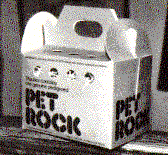Pet Rocks were a 1975 fad originated in California by salesman, Gary Dahl. They spread like wildfire to the rest of the country. Here was a pet that took no care and still gave its owner a few moments of pleasure.Like most fads, others joined in the explosion, there was even a web site titled, Pet Rock Sanitarium (www.visi.com/~pwkelly) to put your pet rock in. Now they live on in ebay by the hundreds and are mentioned over and over in essays on the culture of that era. A history of the Pet Rock era is given below.
This article is from the Encyclopedia of POP Culture, by Jane and Michael Stern. Harper Perennial Press 1992.
PET ROCKSGary Dahl, as California advertising man, was having drinks with his buddies one night in April 1975 when the conversation turned to pets. As a lark, Mr. Dahl informed his friends that he considered dogs, cats, birds, and fish all a pain in the neck. They made a mess; they misbehaved; they cost too much money. He, on the other hand, had a pet rock, and it was an ideal pet - easy and cheap, and it had a great personality. His buddies started to riff with the off-the-wall idea nd pretty soon they were al tossing around the notion of a pet rock and all the things it was good for. Dahl spent the next two weeks writing the Pet Rock Training Manual - a step-by-step guide to having a happy relationship with your geological pet, including instructions for how to make it roll over and play dead and how to house train it. "Place it on some old newspapers. The rock will never know what the paper is for and will require no further instruction.' To Accompany the book, Dahl decided to actually create a Pet Rock. He went to a builder's supply store in San Jose and found the most expensive rock in the place - a Rosarita Beach Stone, which was a uniform size, rounded gray pebble that sold for a penny. He packed the stone in excelsior in a gift box shaped like a pet carrying case, accompanied by the instruction book. The Pet Rock was introduced at the August gift show in San Francisco (the gift market is much easier to break into than the cutthroat toy market), then in New York. Neiman-Marcus ordered five hundred. Gary Dahl sent out homemade news releases of himself accompanied by a picture that showed him surrounded by boxes of his Pet Rocks. Newsweek did a half-page story about the nutty notion, and by the end of October Gary Dahl was shipping ten thousand Pet Rocks every Day. He appeared on "The Tonight Show," twice. By Christmas when, two and a half tons of rocks had been sold, three-fourths of all the daily newspapers in America had run Pet Rock stories, often including Gary Dahl's tongue-in-cheek revelations about how each rock was individually tested for obedience at Rosarita Beach in Baja, Mexico, before being selected and boxed. A million rocks sold for $3.95 apiece in just a few months, and Gary Dahl - who decided from the beginning to make at least one dollar from every rock - had become an instant millionaire. Copycat rocks flooded the market, including one cleverly marketed as "the Original Pet Rock," and dozens of quick-buck entrepreneurs joined the action selling such ancillary fun as Pet Rock Obedience Lessons and Pet Rock Burial-at-Sea Services. Immediately after Christmas 1975, Gary Dahl himself relabeled leftover Pet Rocks as Valentine's Day gifts for loved ones in need of a low-maintenance pet, but the Pet Rock quickly became last year's fad. Dahl quit his job in advertising and formed Rock Bottom Productions and two years later he was interviewed by Don Kracke, the inventor of Rickie Trickie Sticky bathroom appliques, for Mr. Kracke's book How to Turn You Idea Into a Million Dollars. Dahl confided to Kracke, "I've got four more ideas. Wait 'll you see'em!" We have been unable to determine if any of the four ideas have seen the light of day. Whatever his fortunes after the Pet Rock, Gary Dahl has become one of the great motivational figures of recent times. To Don Kracke and to other inventors, like Ken Hakuta (author of How to Create Your Own Fad and Make a Million Dollars) and Robert L. Shook (author of "Why Didn't I Think of That!), the story of the Pet Rock is a never-ending source of inspiration to create new crazes that sweep the nation and make millions for the genius who thought of them. To most noninventive people who remember it, the Pet Rock, like Deely Bobber head antennae and the Hula Hoop has become one of the mind-boggling examples of inexplicable market-place mania. But Ken Hakuta does have an explanation for the periodic success of what he calls "useless dumb jokes" like the Pet Rock: It gave people a few moments of absolutely meaningless pleasure in a troubled world - no small accomplishment. "If there were more fads," Hakuta observed, "there would probably be a lot fewer psychiatrists. ... Instead of paying $100-an-hour therapy sessions, you could just get yourself a couple of Wacky Wallwalkers (a rubber toy that sticks and wiggles on a wall, which earned Hakuta $20 million) and a Slinky and lock yourself up in a room for a couple of hours. When you came out, you'd be fine."
|
|

